The Economics and Statistics Division maintains archives of previous publications for accountability purposes, but makes no updates to keep these documents current with the latest data revisions from Statistics Canada. As a result, information in older documents may not be accurate. Please exercise caution when referring to older documents. For the latest information and historical data, please contact the individual listed to the right.
<--- Return to Archive
For additional information relating to this article, please contact:
October 17, 2023ANALYSIS OF CONSUMER PRICE INDEX FOR SEPTEMBER 2023 Nova Scotia’s all items Consumer Price Index (CPI) increased 4.8% year-over-year in September 2023. Nova Scotia's inflation had been slowing after peaking at 9.3% in June 2022 but started to grow again in July 2023. Nova Scotia’s recent growth in inflation is due to base year effects in gasoline prices, as the large monthly drop in July 2022 is no longer included in 12-month calculations. September all items CPI was down 0.2% compared the previous month.
Nationally, consumer prices increased 3.8% year-over-year in September 2023, following a 4.0% increase in August. Inflation was highest in Nova Scotia and Quebec. Manitoba reported the slowest inflation.
The most significant upward contributors (combining price increase as well as share of the consumption basket) to Nova Scotia's 4.8% year-over-year inflation were: gasoline, rent, mortgage interest cost, food purchased from restaurants, and personal care supplies and equipment. These were offset by downward year-over-year contributions from: telephone services, internet access services, inter-city transportation, child care and housekeeping services, and household textiles.
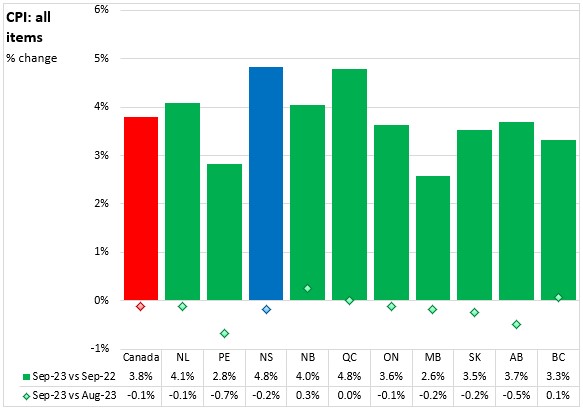
On a monthly basis, Nova Scotia's all items CPI was down 0.2% from August to September 2023. National prices were down 0.1% with decreases in seven provinces. New Brunswick reported the highest percentage gain while Prince Edward Island posted the largest monthly decline.
Nova Scotia's monthly inflation was influenced by upward contributions from: fuel oil and other fuels, furniture, mortgage interest cost, bakery products, and rent. These upward contributors to Nova Scotia's monthly CPI were offset by some notable downward contributors: traveller accommodation, inter-city transportation, gasoline, paper, plastic and aluminum foil supplies, and sugar and confectionery.
Energy prices play a significant role in inflation rates. Nova Scotia's energy prices were up 12.3% from September 2022 to September 2023. Year-over-year energy prices were up 5.4% nationally with increases in eight provinces. Alberta reported the largest increase while Manitoba reported the largest decline.
On a monthly basis, Nova Scotia's energy prices increased 1.0% from August to September 2023. National energy prices were down 1.0% with declines in five provinces. New Brunswick reported the largest monthly increase in energy prices while Alberta posted the largest monthly decline.
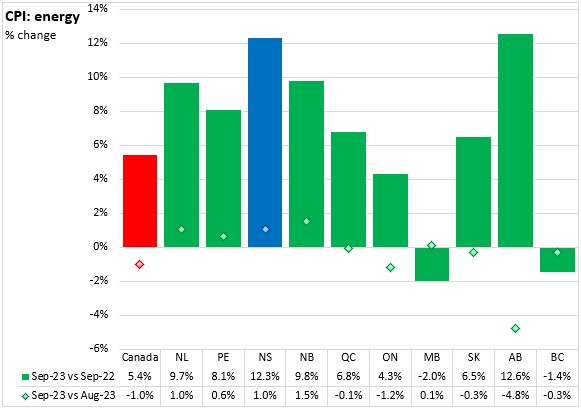
Because fuel oil for home heating is a larger component of Nova Scotia's consumption basket than in other provinces, Nova Scotia's energy prices (and overall inflation) are more sensitive to fluctuations in the global price of crude oil. Nova Scotia's energy prices accelerated dramatically after Russia's invasion of Ukraine in March 2022. Nova Scotia energy prices peaked in June 2022, and then trended down before rising substantially in October and November 2022. Energy prices in Nova Scotia rose again in July 2023 with the introduction of the federal carbon levy. Nova Scotia year-over-year energy inflation, particularly gasoline and fuel oil, continue to be impacted by the federal carbon levy in September 2023.


Nova Scotia's year-over-year energy price growth accelerated from +5.7% in August to +12.3% in September. Prior to August there were five months of declines.
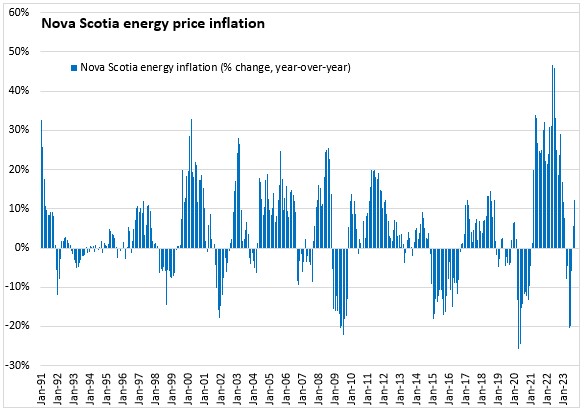
Food price inflation was 6.2% in Nova Scotia (September 2023 vs September 2022). National food prices increased 5.9% in September, down from the 6.8% gain reported in August. Food prices were up in all provinces; Quebec and Prince Edward Island reported the highest food price inflation while Saskatchewan reported the least food price growth (though it was still 5.0%).
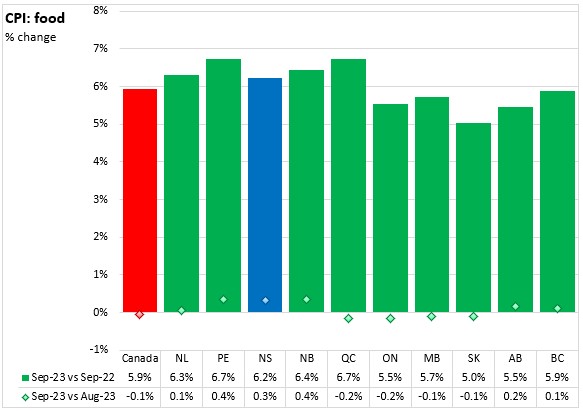
On a monthly basis, Nova Scotia's food prices were up 0.3% from August to September. National food prices were down 0.1% with declines in four provinces. New Brunswick and Prince Edward Island reported the largest increase, while Quebec and Ontario reported the largest decline.
Food and energy prices are heavily influenced by volatile global commodity markets. Nova Scotia's underlying inflation rate excluding food and energy was 3.5% from September 2022 to September 2023. This was the second fastest among provinces (after Quebec). Nationally, inflation excluding food and energy was 3.2%. Quebec reported the fastest growth while Prince Edward Island reported the slowest growth in inflation excluding food and energy prices.
On a monthly basis, Nova Scotia's inflation for all items excluding food and energy was -0.5% from August to September 2023. Nationally, prices for all items excluding food and energy were down 0.1% with the largest decline in Prince Edward Island. New Brunswick and British Columbia reported the only monthly increases.
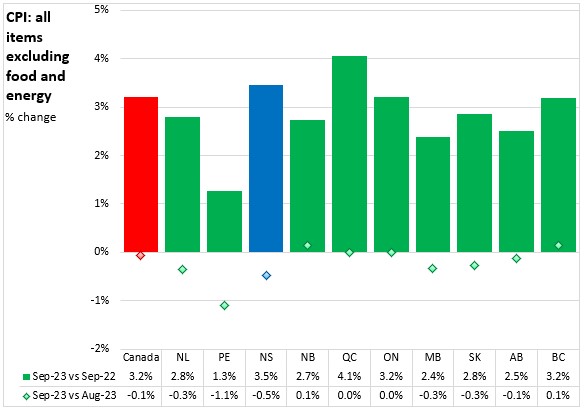
Shelter cost inflation increased to 6.8% in Nova Scotia from September 2022 to September 2023, accelerating from a 6.2% year-over-year increase reported in August. National shelter prices were up 6.0% with gains in all provinces. Alberta reported the largest year-over-year increase in shelter prices while Prince Edward Island reported the smallest.
Monthly shelter costs were up 1.0% in Nova Scotia from August to September 2023. Nationally, shelter costs were up 0.5% with gains in all provinces except Alberta.
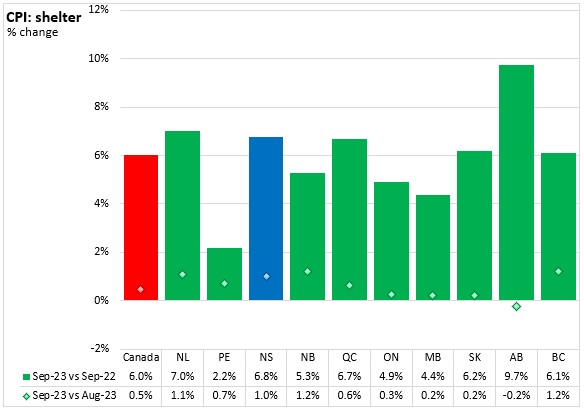
Among detailed food products with available data, Nova Scotia's year-over-year inflation was fastest for chicken, with many food products reporting year-over-year inflation in excess of 5% in September. Lower prices were reported in eggs and Coffee and tea compared to September 2022.

In detailed shelter cost components, home and mortgage insurance reported the fastest year-over-year price increases, followed by rent. Home maintenance and repairs and homeowners' replacement costs reported declines.
Household operations/furnishings costs were down 1.4% overall. Prices were down for all components except utensils/tableware/cookware, furniture, paper/plastic/aluminum products, and cleaning products. The largest decline was in internet access.
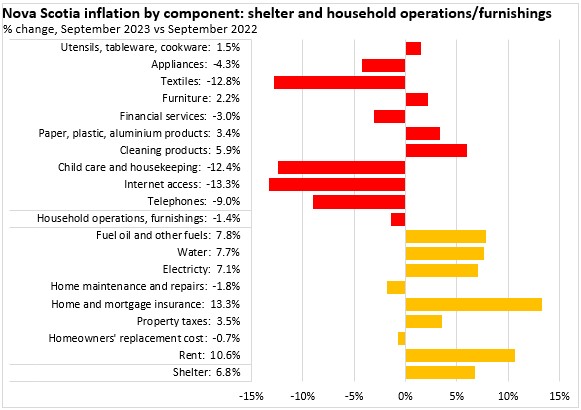
Overall transportations costs were up 6.1% year-over-year in September. Gasoline prices increased the fastest while inter-city transportation had the largest decline.
Health and personal care costs were up 7.0% year-over-year on gains in all sub-components led by personal care supplies.
Clothing and footwear prices were up 1.7% year-over-year in September with women's clothing reporting the largest price gains. Children’s clothing posted the largest year-over-year decline in September.
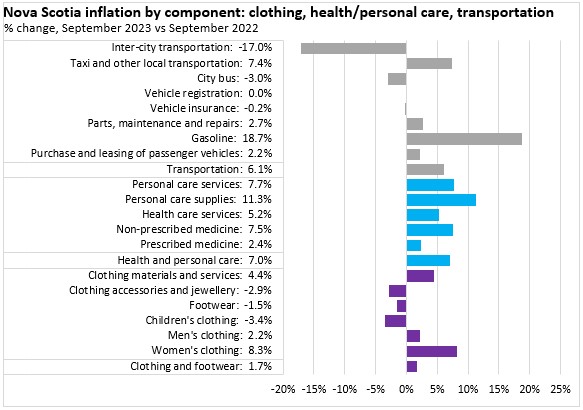
Nova Scotia's overall prices for recreation, education and reading were up 3.9% from September 2022 to September 2023, with faster increases for purchase/operation of recreational vehicles and other culture/recreation. Prices declined from the previous year in home entertainment equipment/services and recreational equipment/services (excluding RVs).
Nova Scotia's prices for alcohol, tobacco and recreational cannabis were up 5.3% year-over-year with the fastest growth in cigarette prices.
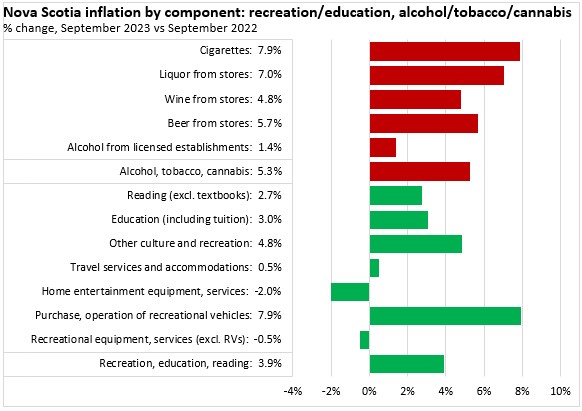
Trends
Since the start of the Bank of Canada's inflation-targeting monetary policy regime, inflation for all items has generally been in the 0-4% range. Periods of above target inflation are typically followed by periods of slow price growth or declines. The most recent acceleration in inflation was the strongest since the inflation-targeting era began.

Many of these periods of accelerated and slowed inflation are attributable to volatile commodity prices, especially energy prices. Once the more volatile commodity prices are excluded, inflation in Nova Scotia has largely been below 2% for much of the last 20 years. However, the recent rise in inflation through 2021-2023 spreads beyond commodity prices, resulting in the longest period with CPI excluding food and energy above 3%.

The Bank of Canada examines 'core' measures of inflation that are intended to remove the effects of volatile components and capture underlying inflation trends that are more connected to capacity in the Canadian economy. Core measures of inflation may also indicate where all items inflation is headed.
Canada's core measures of inflation remained mostly at or below the Bank's target of 2% for over a decade prior to 2021. However, after prices accelerated in 2022, core inflation measures also started to rise, peaking at over 6% for the CPI-common measure before declining. Compared to the previous month, year-over-year core inflation measures in September 2023 slowed for CPI-common (+4.4%), CPI-median (3.8%), CPI-trim (3.6%) and CPI-core (2.8%).
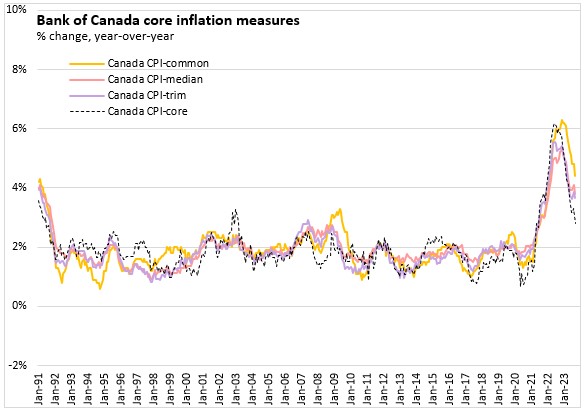


Source: Statistics Canada. Table 18-10-0004-01 Consumer Price Index, monthly, not seasonally adjusted; Table 18-10-0256-01 Consumer Price Index (CPI) statistics, measures of core inflation and other related statistics - Bank of Canada definitions
<--- Return to Archive